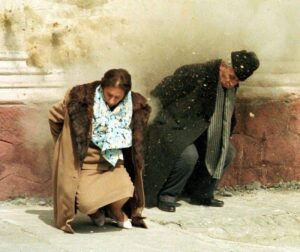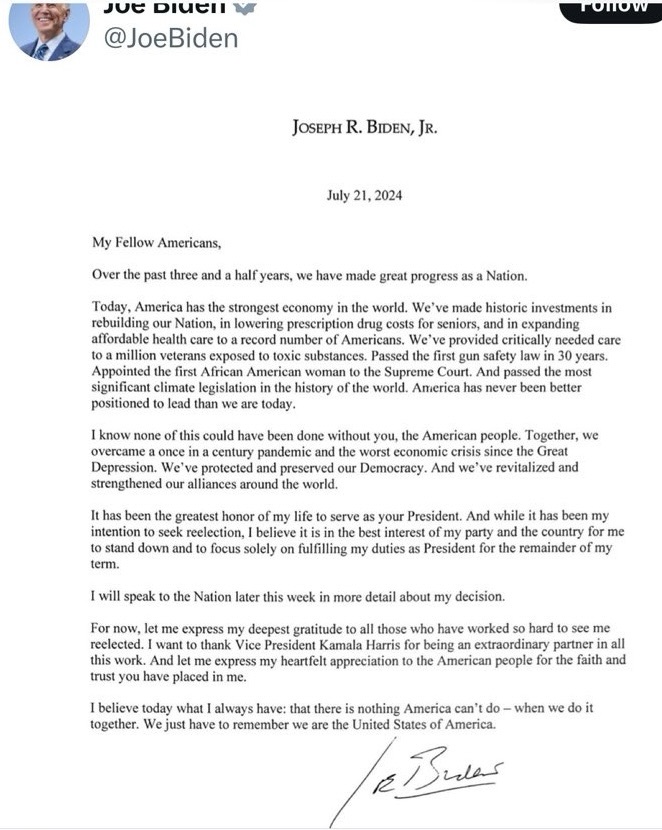Professional photographer sends: NYT photographer was set up to shoot super-high speed… as if to capture Trump’s head exploding
🚨 NYT CAUGHT RED-HANDED? 🚨
Their photographer captured the bullet whizzing past Trump settings you’d use to capture a HEAD EXPLODING.
Camera was set at 1/8000 second shutter and f/1.6
Coincidence? Experts are raising serious questions. #AssassinationPlot #NYT #FalseFlag pic.twitter.com/qmCj7PwswM
— 459 Crimes (@459Crimes) July 18, 2024
Ann-
I can tell you. In all my years of photography. I never set a camera to 1/8000th of s second shutter. Only specialized lenses have apertures that go into the 1.4, 1.6, 1.8 range with the “fastest” greatest opening lens being about, .9. You need a LOT of light (light broad daylight) to shoot at 1/8000th of a second. You could never capture it indoors. This also would have been shot in rapid succession so there would be at least 30-40 frames BEFORE and AFTER this photograph which would allow investigators to actually track exact trajectory. (or see other bullets). I agree that the when the FBI director says “shrapnel or glass” there is a deep, DeepState issue.
I say again: all of the talk, bluster and outrage in the media and from Washington DC garbage humans about “incompetence” is pure head-fake.
The attempted assassination of Trump was meticulously planned, down to making sure that Zabraham Apruder was front-and-center with his shutter speed set to unthinkably fast levels, and that he was leaning on the shutter when Lee Harvey Asperger open fired so that Clown World would have their snuff reel of Trump’s brains being aerosolized with which to terrorize humanity.
Stickypost: Mazza-U presents SuperHeretics vs. SuperSaints AND Mary! More Awesome than Armies!
SuperHeretics vs SuperSaints of the Reformation: Luther, Calvin, Henry VIII, St. Ignatius, St. Philip Neri, St. Thomas More, St. Teresa of Avila & More!
MARY! More Awesome Than Armies! More Agile than Assassins!
St. Anne with an “e”, pray for us, and pray for me!
Today is the Feast of St. Anne, the grandmother of Our Lord. Given that, she is obviously a POWERFUL intercessor. If you recall, back in ARSH 2018 when SuperNerd and SuperMommy were in desperate need of overnight home care assistance for St. Tiny Princess, we did a Novena to St. Anne, and she delivered promptly and BIGLY with the Sister Servants of Mary – Ministers to the Sick.
If you or anyone you know is in need of authentically Catholic, morally sane end-of-life care, especially, see if the Sister Servants of Mary are in your area. Also consider them a “safe Catholic tithe”.
Can you imagine having nursing care from women who spend an hour before Our Lord in the Monstrance, begging Him to let them see Him in the sick that they are about to care for, before going on shift, every day?
What has been stolen from us isn’t limited to the Liturgy. Education, healthcare, culture, music, architecture, clothing, everything has been touched and destroyed by the collapse of the Catholic Church since Vatican II (1965) and the Novus Ordo Mass (1969). If you think these things are merely coincidental, well, I can’t help you at this late hour.
The name “Anne” from the Hebrew “Hannah” means “Grace”, which is “Grátia” in Latin, and so the names Anne and Grace are Hebrew-Latin equivalents. So happy name day to all of the Graces out there too!

Santiago y cierra España!

Who is this dashing figure manfully wielding his ASSAULT WEAPON whilst trampling and slaying a bunch of quivering, cowering musloids on a field of battle?
That’s St. James the Apostle, son of Zebedee, big bruddah of St. John. I know you probably didn’t recognize him because of the hat. Well, if you’re going to miraculously appear in Spain in the 9th century and lead a vastly outnumbered Christian Army against an invading musloid force, slaying musloids by the boatload, someone is bound to give you their sweet hat.
St. James made a beeline for Spain to begin evangelizing after the Ascension of Our Lord. Tradition has St. James in Spain in the year ARSH 40. 804 years later, at the battle of Clavijo against the satanic musloid hordes, St. James miraculously appeared in his old home-away-from-home and, evidently, put on a clinic on killing musloids.
St. James, adopted son and patron of Spain, has ever since been known as “Santiago Matamoros”, St. James the Moorslayer (mata = kill or slay, moros = musloids).
To this day the battle charge cry of Spanish armies remains:
Santiago y cierra España!
St. James, and strike for Spain!

St. James the Greater, Guido Reni, ARSH 1638, Museum of Fine Arts, Houston
New Latino breakfast pastry: Oreja Trump

Chocolate dipped puff pastry. Trump Ear.
All of this blustering about getting Cheatle to resign is pure misdirection. This isn’t about people RESIGNING. This is about attempted First Degree Murder of Trump, and the collateral murder of Corey Comperatore within the same conspiracy. We’re talking death penalty, here. Not resigning to a corporate payoff job and pension.
And it isn’t just Cheatle.
The congressional hearings were theater. Cheatle and everyone involved in Trump’s security detail should be arrested for conspiracy to commit first degree murder FOR A START, including every one of those fat-ass TSA screeners masquerading as bodyguards.
Start with them, and see if capital murder charges with the death penalty on the table (Corey Comperatore IS dead) doesn’t get people singing.
NOTHING will change unless and until not just execution, but public executions are meted out. And that goes for government oligarchs all the way down to gang-bangers looting Foot Lockers and carjacking suburbanites. In fact. it would be absolutely perfect and apropos to see criminal oligarchs interspersed with gang-bangers and child molesters as they’re lined up against a wall and sprayed with .223 all together.
Because diversity. And equality.

Feast of Mary Magdalen: Some woman trying REALLY hard to look like a lesbian tried to throw me out of a perpetual Adoration chapel while I’m on pilgrimage. Nice try, satan. I prayed all 15 Mysteries.
I just had one of the most Grace-filled Rosaries I’ve had in several years. I’m on pilgrimage, and I stopped into a perpetual Adoration Chapel in a town I periodically visit to pray the Joyful Mysteries of the Rosary.
I’m dressed typically for me- a dress that’s considered formal-wear today, hat, although I didn’t have my gloves on. I’ve been slack on the gloves. It’s been REALLY hot.
I walk in, double genuflect before Our Eucharistic Lord exposed in the monstrance, and kneel in the front pew on the far right. I take out my Rosary and get started, and this… female, let’s call her “Terry”, comes up and tells me to take off my hat. Now, understand, Terry has a $6 crew cut and is wearing a wife-beater and sweat shorts. I say at a whisper, “Absolutely not. Women must cover their heads before the Blessed Sacrament, always.” Terry says, “No, take off your hat.”
At this point, I “got loud” in the sense that I spoke aloud in normal voice, not whispering, which is very intense before Our Lord in the Monstrance. I repeated, “NO. I will NOT take off my hat because I am a WOMAN, and women cover their heads before the Blessed Sacrament, ALWAYS.”
At which point Terry ran off into the nave of the church. Because, as I’ve said for nearly 15 years now, if you just step to these people with confidence and authority, they’ll turn tail 99 times out of 100. Terry messed with the wrong behatted Catholic spinster.
So, I obviously prayed all 15 Mysteries of the Rosary there. And it was one of the most consoling, open, mentally free and Grace-filled Rosaries I’ve prayed in quite a while. I asked St. Mary Magdalen to pray with me on her feast day today, and every Mystery seemed to have a deep and informative meaning and intention to me today. And yes, of course I prayed for Terry, especially at the 4th Joyful Mystery – love of the Law and Holy Obedience, and the 5th Joyful Mystery- Joy at Finding Jesus. I hope she finds Him, and in finding Him finds her own dignity as a woman and as a Catholic.
And I prayed for all of you, obviously, as I always do.
St. Mary Magdalen, pray for us.
Lord Jesus Christ in the Most Holy Sacrament of the Altar, have mercy on us. Everyone.
This is Gibson’s Raising of the Crucified Christ scene. His depiction of The Magdalen pulling her veil over her head at the end of this clip is… sublime.
Well… BYE.

The Deep State wanted his brains blown out on live, global feed. They were going for a global psychological terroristic trauma on par with 9/11 and the lockdowns. The fact that Lee Harvey Asperger missed in a “miraculous” fluke should not take away from the evil revealed.
We’re a week after the fact of the attempted assassination, and we’ve got enough information and context to put some notes down, although there is still data emerging.
1. It was absolutely an attempt to blow Donald J. Trump’s brains out on global live television. Trump wasn’t “in on it”. You don’t let a sniper come within less than an inch of killing or doing permanent catastrophic brain damage to you. Besides, it is obvious that it was just the “miraculous” turning of Trump’s head at the exact moment that Lee Harvey Asperger squeezed off the shot that Trump is alive, or at best permanently brain-damaged, as was James Brady in ‘81. Lee Harvey Asperger was aiming at Trump’s right temple. Had Trump not flinched, the hit would have been gruesome, and everyone on earth would have seen it, with Americans seeing it in real time.
2. Trump’s Secret Service detail was NOT secret service. It was a bunch of fat-ass women barely qualified to work airport security lines. It looks likely that Jill Biden was instrumental in setting this up. Yes, it seems very likely that Jill and Hunter are absolutely desperate to cling to their power – because everyone on planet earth knows that Joe Biden doesn’t have the mental capacity to decide when and where to have a bowel movement, much less run the Former USA. I highly recommend reading Naomi Wolf’s piece on this. It is sober and well-informed. The “incompetence” of Trump’s security AND the obvious assistance Lee Harvey Asperger received is proof beyond a doubt that this was a calculated “green flag” FEDGOV plot.
3. I’ve seen the photo of the tranny-looking man going around that is purported to be Lee Harvey Asperger. More confirmation there is needed. There’s a helluva lot of ugly spergs out there. However, it has been revealed today that the last search Lee Harvey Asperger made on his phone on Saturday afternoon was for p**nography. Although what KIND of p*** was not specified. Someone needs to track down his coworkers at the nursing home he worked at and find out if he was a transvestite/sodomite.
4. While I’ve used the word “miraculous” to describe the head-turn of the millennium, I want to make it clear that I don’t think Trump is at the right hand of Our Lady of Fatima. I think that Trump, like all of us, is subject to The Divine Providence, which is always perfect. I warn strongly against trying to force the person of Donald Trump into the mold of a living saint, or even of a King David character. Let me hasten to remind one and all that King David wrote the psalter of divinely inspired hymns of penitence, sadness, and praise of God’s mercy because King David was SORRY for his sins. Donald Trump played golf on Sunday morning after just coming off a trial centered around his fornicating with p*** stars, and then coming within an inch of having his brains blown out. Where some say, “Playing golf projected strength,” I see a man breaking the Third Commandment (mortal sin) on the one morning of his life that he most surely should have been worshipping the God whose perfect Providence saved his life. Mortal sin never “projects strength.” I’m very, VERY glad Trump wasn’t killed, but I’m not willing to make him what he most clearly is not: some sort of living saint. I do fear that people going down this road are being set up for a terrible disappointment.
5. It’s just being reported as I write this that Fauci, of all people, is downplaying Trump coming within less than an inch of having his calvarium turned inside out as no big deal because Trump ended up with a mere “superficial” wound. And THIS is the major point I want to make in this piece. I think that because Trump did “miraculously” only end up with a grazed ear – and let us not forget that Corey Comperatore DID have his brains blown out as he literally lay atop his family – that EVERYONE is prone to discounting the violent, evil, calculated psychological terror that was attempted. All of the lefty news media carried the Trump rally live, totally against all previous precedent. Up until last Saturday, the media categorically refused to give Trump any “free air time and publicity.” But last Saturday, every camera, every feed, was squarely on Trump’s head. The plan and conscious intention was to blow his brains out on live television and recreate the level of psychological distress that 9/11 caused. While 3000 people died on 9/11, the trauma of seeing Trump being shot in the temple, with brain matter spraying, would have had a visceral and lasting effect. This assassination was intended to cause every person on earth to cower in terror of the New World Order/Deep State, from heads of state, to old widow women in HUD housing in rural Nebraska, and everyone in between, globally. “WE CAN DO THIS TO HIM, AND WE CAN DO IT TO YOU.”
The fact that this was a “miraculously” close call takes NOTHING away from the brazen evil that was exposed by the attempt. Don’t let this fade into the news cycle.
And remember, Corey Comperatore IS dead.
As always, I hope this helps.

